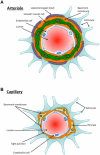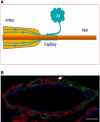Failure of perivascular drainage of β-amyloid in cerebral amyloid angiopathy
- PMID: 24946077
- PMCID: PMC8029317
- DOI: 10.1111/bpa.12159
Failure of perivascular drainage of β-amyloid in cerebral amyloid angiopathy
Abstract
In Alzheimer's disease, amyloid-β (Aβ) accumulates as insoluble plaques in the brain and deposits in blood vessel walls as cerebral amyloid angiopathy (CAA). The severity of CAA correlates with the degree of cognitive decline in dementia. The distribution of Aβ in the walls of capillaries and arteries in CAA suggests that Aβ is deposited in the perivascular pathways by which interstitial fluid drains from the brain. Soluble Aβ from the extracellular spaces of gray matter enters the basement membranes of capillaries and drains along the arterial basement membranes that surround smooth muscle cells toward the leptomeningeal arteries. The motive force for perivascular drainage is derived from arterial pulsations combined with the valve effect of proteins present in the arterial basement membranes. Physical and biochemical changes associated with arteriosclerosis, aging and possession of apolipoprotein E4 genotype lead to a failure of perivascular drainage of soluble proteins, including Aβ. Perivascular cells associated with arteries and the lymphocytes recruited in the perivenous spaces contribute to the clearance of Aβ. The failure of perivascular clearance of Aβ may be a major factor in the accumulation of Aβ in CAA and may have significant implications for the design of therapeutics for the treatment of Alzheimer's disease.
Keywords: Alzheimer's disease; amyloid β; cerebral amyloid angiopathy; interstitial fluid neuroimmunology; perivascular drainage.
© 2014 The Authors. Brain Pathology published by John Wiley & Sons Ltd on behalf of International Society of Neuropathology.
Figures


References
-
- Ashford JW (2004) APOE genotype effects on Alzheimer's disease onset and epidemiology. J Mol Neurosci 23:157–165. - PubMed
Publication types
MeSH terms
Substances
LinkOut - more resources
Full Text Sources
Other Literature Sources

